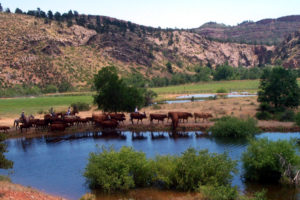Livestock Improve Water Holding Capacity of Soil
 Here at Sylvan Dale we are using cattle to help build up organic matter and carbon content of our soils. The technique: planned, rapid rotation grazing. It turns out this also helps the soil conserve water. Here’s a post from Dr. Roy Roath, CSU Professor Emeritus, describing a grazing experiment he conducted on range land in Northern Colorado:
Here at Sylvan Dale we are using cattle to help build up organic matter and carbon content of our soils. The technique: planned, rapid rotation grazing. It turns out this also helps the soil conserve water. Here’s a post from Dr. Roy Roath, CSU Professor Emeritus, describing a grazing experiment he conducted on range land in Northern Colorado:
In a program implemented north of Fort Collins in a ‘short grass prairie” receiving an average of 10-12 inches of annual precipitation; we implemented a grazing program designed explicitly to greatly increase water capture and retention. This requires a designed rotational grazing program to allow use, foster tillering and plant recruitment and management for growth and regrowth to full recovery in every pasture every year. In doing this we were able to increase forage on offer, leave greater residual cover and increase the diversity of the stand including greatly increasing the forb component. What we found is that the “short grass prairie” was really a mixed grass prairie suppressed by years of inappropriate grazing. We soon had major increases in cool season grasses and forbs and many tall warm season grasses that were not evident and not even thought to be a part of this ecosystem when we started. After five years in this program we had two dry streambeds that became streams that flowed 365 days a year and began to grow riparian vegetation the full length of their corridor. A critical part of this management strategy is to regain and manage cover on the primary terraces bordering the streambed. These are water storage areas and must have structure and cover to maintain the integrity to the stored water in the system. I can’t say that this works everywhere but I have enough experience in a variety of environments to know that one can vastly improve water capture and in doing so has a great probability of good things happening.
